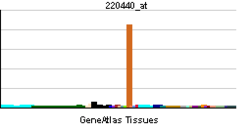LGALS13
Galactoside-binding soluble lectin 13 or placental protein 13 (PP13) is a protein that in humans is encoded by the LGALS13 gene.[2][3][4]
Structure and function
Lysophospholipases are enzymes that act on biological membranes to regulate the multifunctional lysophospholipids. The protein encoded by this gene has lysophospholipase activity. It is composed of two identical subunits which are held together by disulfide bonds. This protein has structural similarity to several members of the beta-galactoside-binding S-type lectin family.[4]
Clinical significance
PP13 levels that are low in the first trimester of pregnancy confers a higher risk for developing pre-eclampsia later in pregnancy.[5]
References
- ↑ "Human PubMed Reference:".
- ↑ Bohn H, Kraus W, Winckler W (Jul 1983). "Purification and characterization of two new soluble placental tissue proteins (PP13 and PP17)". Oncodev Biol Med. 4 (5): 343–50. PMID 6856484.
- ↑ Than NG, Sumegi B, Than GN, Berente Z, Bohn H (Dec 1999). "Isolation and sequence analysis of a cDNA encoding human placental tissue protein 13 (PP13), a new lysophospholipase, homologue of human eosinophil Charcot-Leyden Crystal protein". Placenta. 20 (8): 703–10. doi:10.1053/plac.1999.0436. PMID 10527825.
- 1 2 "Entrez Gene: LGALS13 lectin, galactoside-binding, soluble, 13 (galectin 13)".
- ↑ Huppertz B, Meiri H, Gizurarson S, Osol G, Sammar M (February 2013). "Placental protein 13 (PP13): a new biological target shifting individualized risk assessment to personalized drug design combating pre-eclampsia". Hum. Reprod. Update. 19 (4): 391–405. doi:10.1093/humupd/dmt003. PMID 23420029.
Further reading
- Wang A, Dennis EA (1999). "Mammalian lysophospholipases". Biochim. Biophys. Acta. 1439 (1): 1–16. doi:10.1016/s1388-1981(99)00063-3. PMID 10395961.
- Uhlmann J, Wiemann S, Ponstingl H (1999). "DelGEF, an RCC1-related protein encoded by a gene on chromosome 11p14 critical for two forms of hereditary deafness". FEBS Lett. 460 (1): 153–60. doi:10.1016/S0014-5793(99)01333-2. PMID 10571079.
- Visegrády B, Than NG, Kilár F (2002). "Homology modelling and molecular dynamics studies of human placental tissue protein 13 (galectin-13)". Protein Eng. 14 (11): 875–80. doi:10.1093/protein/14.11.875. PMID 11742106.
- Sjölinder M, Uhlmann J, Ponstingl H (2003). "DelGEF, a homologue of the Ran guanine nucleotide exchange factor RanGEF, binds to the exocyst component Sec5 and modulates secretion". FEBS Lett. 532 (1–2): 211–5. doi:10.1016/S0014-5793(02)03677-3. PMID 12459492.
- Strausberg RL, Feingold EA, Grouse LH (2003). "Generation and initial analysis of more than 15,000 full-length human and mouse cDNA sequences". Proc. Natl. Acad. Sci. U.S.A. 99 (26): 16899–903. doi:10.1073/pnas.242603899. PMC 139241
 . PMID 12477932.
. PMID 12477932.
- Than NG, Pick E, Bellyei S (2004). "Functional analyses of placental protein 13/galectin-13". Eur. J. Biochem. 271 (6): 1065–78. doi:10.1111/j.1432-1033.2004.04004.x. PMID 15009185.
- Burger O, Pick E, Zwickel J (2004). "Placental protein 13 (PP-13): effects on cultured trophoblasts, and its detection in human body fluids in normal and pathological pregnancies". Placenta. 25 (7): 608–22. doi:10.1016/j.placenta.2003.12.009. PMID 15193867.
- Gerhard DS, Wagner L, Feingold EA (2004). "The Status, Quality, and Expansion of the NIH Full-Length cDNA Project: The Mammalian Gene Collection (MGC)". Genome Res. 14 (10B): 2121–7. doi:10.1101/gr.2596504. PMC 528928
 . PMID 15489334.
. PMID 15489334.
- Chafetz I, Kuhnreich I, Sammar M (2007). "First-trimester placental protein 13 screening for preeclampsia and intrauterine growth restriction". Am. J. Obstet. Gynecol. 197 (1): 35.e1–7. doi:10.1016/j.ajog.2007.02.025. PMID 17618748.

 . PMID 12477932.
. PMID 12477932. . PMID 15489334.
. PMID 15489334.